This is a TRUE, SUCCESSFUL & UNREQUESTED story from George Harris, one of our customers.
“Mr Harris presents a very interesting Case Study on a Manual Action Recovery, where he outlines the fact that webmasters need to be perseverant and the recovery will finally happen. Lots of webmasters fail at Google Recoveries due to the fact that they expect it to happen after their first Google Disavow or Link Removal campaign. It may take a few reconsideration requests until you get the recovery, unless you do it exceptionally well the first time! “
We were approached by a company in 2014 whose website had been issued with a Partial Google Penalty for unnatural inbound links. This post details the precise steps we took to resolve the penalty and everything we learnt along the way. The client wishes to remain anonymous so all references to them have been removed.
The Unnatural InBound Link Warning from Google Webmaster Tools
The chances are that you’re already familiar with the following message in Google Webmaster Tools. It means your SEO and Marketing efforts are going to be sidetracked for a while:
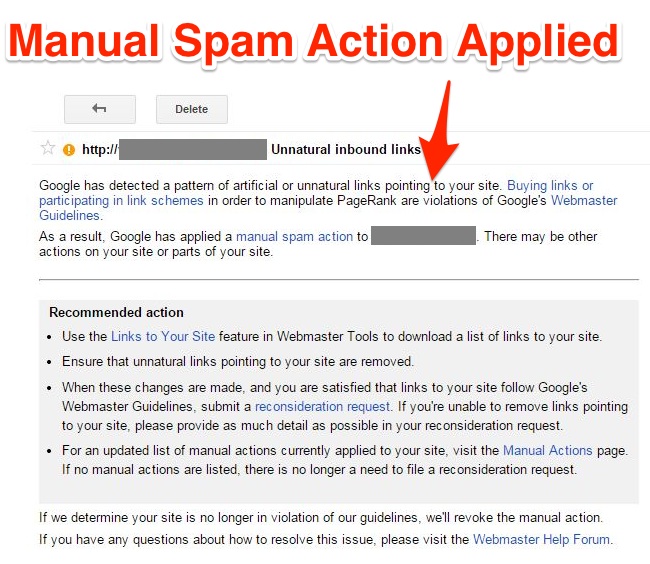
Manual Spam Action Applied in March 2014
Firstly was to establish if this penalty was genuine or as a result of a Negative SEO attack. This didn’t take long as it was clear that the company had already been hit by a Penguin Algorithmic Penalty in 2012 which decimated their Organic traffic.
They never recovered from the algorithmic penalty, and had moved away from SEO into Social, Affiliate and Paid Advertising. They had started to re-invest in SEO a couple of months earlier, and after their ex-digital agency built a handful of poor backlinks, they’d been given this partial manual penalty.
First Step – Mining the Links
As the penalty was justified based on Google’s Webmaster Guidelines, the next step was to either remove or disavow any toxic, followed, inbound links before filing a reconsideration request.
We collected as many links as we could from Google Webmaster Tools, Bing Webmaster Tools, cognitiveSEO and other link data providers. These link lists refresh quite regularly, so it’s important to continually revisit these sources to get the latest list.
At the start, we thought we could automate it all ourselves. We tried to crawl all links to check if the pages were either still active, and still had followed inbound links pointing to the client website. This gave us our ever-growing list of every single active, followed link.
Next was to separate out the unnatural links.
We could exclude our obviously best links using a number of basic tactics – e.g. public sector domains, PageRank or looking at the number of inbound links a site has.
But it was slow and painful to manage this ever changing list of links.
Part of the reason was the level of concentration required when marking thousands of links as natural or unnatural. You can’t afford to glaze over during this process. Also these websites were sometimes available and sometimes not, so our crawls had to be run regularly to come up with a definitive list. So we looked around for a tool that might help, which is when we discovered CognitiveSEO.
Discovering and Using cognitiveSEO
cognitiveSEO appealed to us as it was a tool that was powerful, affordable and specific to our needs. It offers the exact functionality required to manage and monitor progress in resolving Google Penalties. We took the free trial, signed up and even had a 30 minute introduction call with Razvan Gavrilas, the Chief Architect of the platform, which was a great welcome!
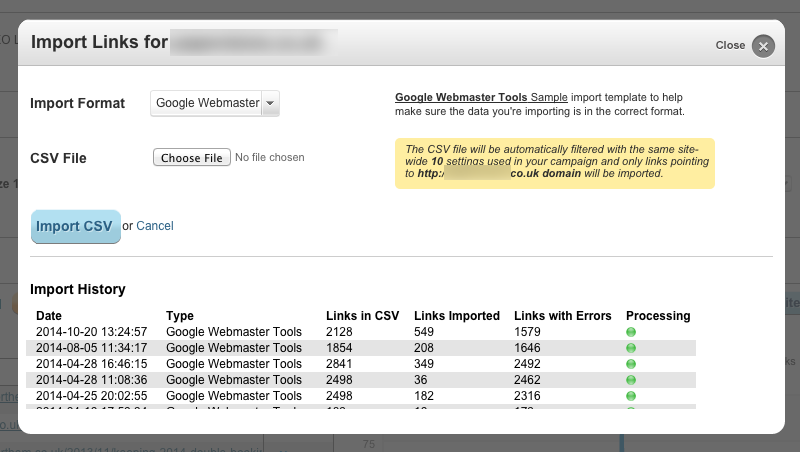
Google and Bing Link Data Extra Imports processed by cognitiveSEO
Firstly, we imported all of the link lists we had collected into our cognitiveSEO campaign. It removed duplicates, stripped out large numbers of links from the same website and generally just tidied things up.
More than one person could now log into the campaign to see how it was progressing, as opposed to dealing with spreadsheets or building our own app.
Using the Automatic Unnatural Link Detection
We wanted to efficiently use the Unnatural Link Detection tool. So, we started by setting up our “commercial” keywords. These were all the anchor text terms that the client had optimised link building campaigns for in the past. We also specified our “brand” keywords, such as the client’s brand name and variations of it.
Once 70% of the links had their anchor text classified as either brand or commercial, the link classification begins and every imported link into the site was set automatically as “OK”, “Suspect” or “Unnatural”.
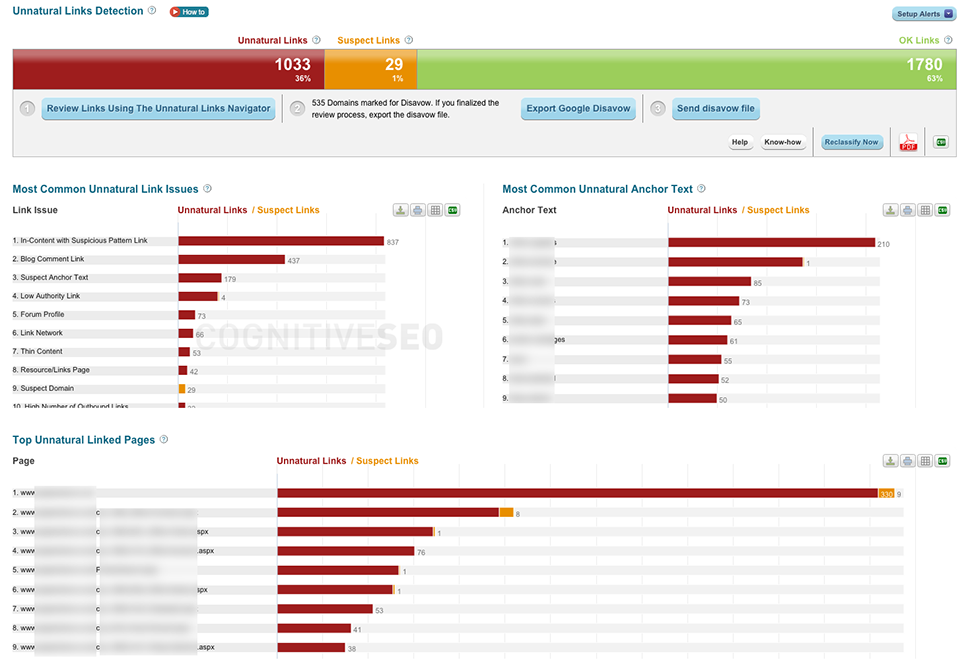
Unnatural Link Detection Analysis on Penalized Site
We loaded up the Unnatural Links Navigator, and using the keyboard shortcuts (it’s definitely worth learning these!) we reviewed every domain that had a link to the client and marked the domain or link for disavow.
To be sure, we checked the “OK” links as well, but there were only a couple of minor exceptions that we had to fix manually.
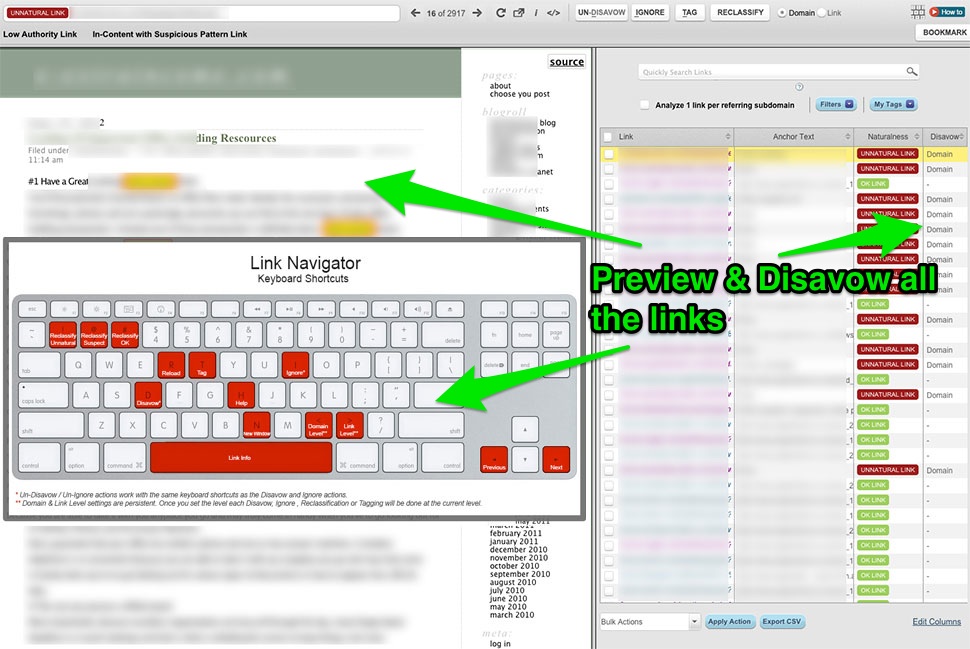
Link Navigator Inspection and Preparation for Google Disavow
CognitiveSEO made the generation of the disavow file very straightforward. It can be a nerve-wracking process to generate this file manually as you don’t want to accidentally include any good links. If you’re paranoid, you can still check that the generated file from CognitiveSEO doesn’t include your best links.
Link Removal Process via Email Campaign
There are no official guidelines as to the number of unnatural links that need to be removed in order for a penalty to be revoked. Anecdotally, the larger the website and the more severe the penalty (i.e. full manual), the more links Google will expect to be removed rather than just disavowed.
We knew our chances of removing links via an email outreach campaign were slim.
This is because of the huge volume of these types of emails being received by Webmasters. You could step things up by offering payment or by threatening legal action but I wouldn’t advise either unless there really are no other options. We were lucky enough to be able to contact our client’s old link-building SEO agency who had kept login details of links placed on forums and bookmarking websites. I strongly recommend this approach for removing links if the agencies still exist. If they don’t exist then go through old emails, try to find mobile numbers or go on LinkedIn or Twitter to find the people who worked there. In my experience, if you’re nice and explain your position to them then you’re more likely to be helped.
We were able to remove links from roughly half of all unnatural domains using these logins, which we could track through cognitiveSEO.

Unnatural Link Drop and Natural Link Growth
Once we’d removed every link we could, we pulled contact details for the webmasters of the other domains – mostly via WHOIS records – and started an outreach campaign over the course of 8 weeks. We emailed each webmaster up to 5 times with an email from the client’s company domain (to add authority to the request). This outreach action was logged as part of the reconsideration request that we sent to Google to show that we had done everything in “good faith” to remove the links.
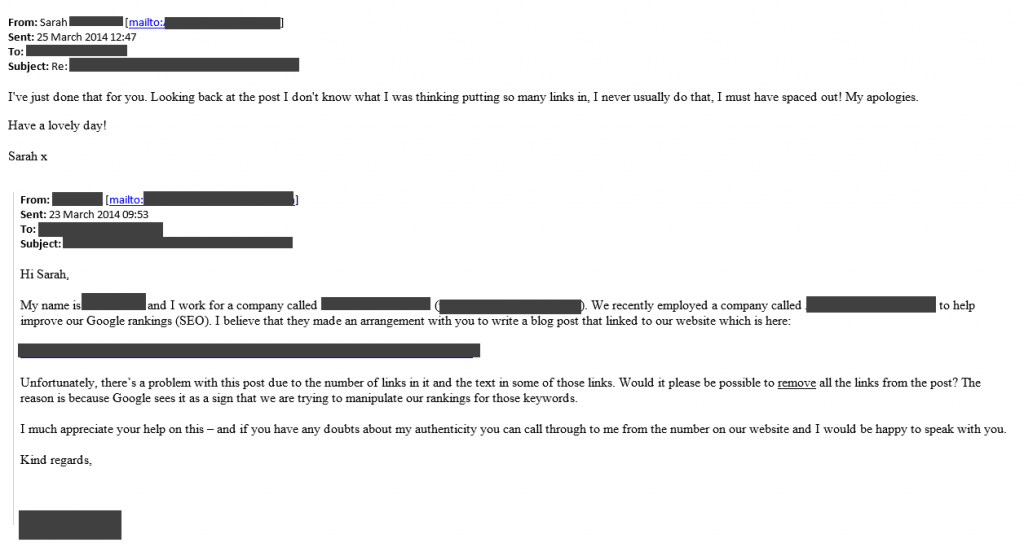
Outreach Email Campaign for Removing Unnatural Links
Sending the Reconsideration Requests
It took us 3 reconsideration requests for the penalty to be lifted.
We included details of the links removed and a link to a Google Spreadsheet with the outreach email statistics. This included whether the mailbox was reachable, if we had a response and how many times they’d been contacted.
Google took between 10-21 days to respond to each reconsideration request so it’s worth making a real effort to get it right.
I’ve also come across cases where reconsideration requests have included the login details for the email address used for outreach. This is something worth considering if you’re having real trouble removing links.
For the two rejections, Google responded with unnatural links that weren’t in the disavow file.
So we patiently re-imported the latest link lists, re-classified them using cognitiveSEO as before and regenerated the disavow file.
Despite all our efforts, I wasn’t given any indication that the removal of links had any positive effect. Only that the disavow file should include every unnaturally linked domain or link.
Given that the link removal process took 90% of our overall time (and ingenuity), we were a bit disappointed that it wasn’t even acknowledged!
Here’s one of the rejection messages – both of the rejections we received each listed 3 URLs that weren’t in the disavow file. Google have since started providing more feedback for rejections rather than these limited stock messages:
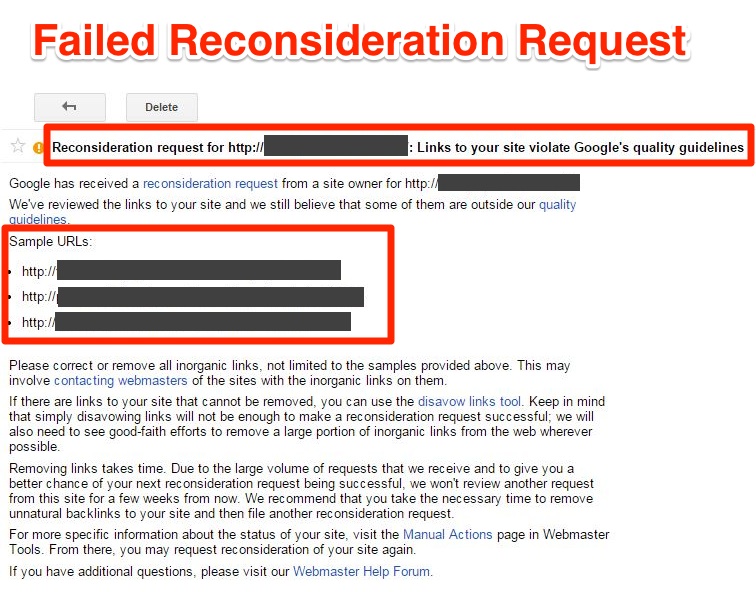
GWT Reconsideration Request- Message from Google
And on the 3rd attempt, we received the message that SEOs dream about:

GWT Message – Manual Spam Action Revoked
The Penalty Recovery Process
This Analytics graph shows organic traffic to the site excluding the homepage. Since it was a partial penalty, brand searches were not affected so this (slightly crudely) shows non-brand traffic:
We had to wait until Penguin 3.0 was refreshed in October 2014 to see another real traffic uplift in the Google Penalty Recovery. Even after the penalty was revoked however, rankings did not return for the keywords the client had specifically built links for in the past. This indicates that Penguin is probably still algorithmically affecting the website and requires further work. However the site is ranking for long tail variations of these keywords which is an improvement.
Disclosure
This is not a paid post and cognitiveSEO didn’t make any kind of agreement with the author. This is the success recovery story of George Harris, written and documented by himself.
About the Author
George Harris – Online Marketing, E-Commerce and Technology Consultant – Web Method
Twitter https://twitter.com/methodicalweb

 Site Explorer
Site Explorer Keyword tool
Keyword tool Google Algorithm Changes
Google Algorithm Changes



Nice story Razvan & George!
Dear Razvan Gavrilas!
Thanks for sharing this very great article with high-value insights on the latest Google Penguin Webspam Update. It really shows in deep that you can overcome all trouble by cleaning up the mess others might have produced.
It works if you put enough effort in cleaning up all the link-dirt. For me personally the Cognitive Linkexplorer with all its power is the very best tool to find all the low level links pointing to a certain website. As a semantic seo-copywriter from Linz in Austria I always keep on reading your great stuff on this awesome blog. I also own the great cognitive seo-tool-suite which I can recommend to everybody out there. The Cognitive Seo-tools are really helpful and very well developed. They offer a great interface and an assume user experience. Keep on going like this.
Best Regards
Wolfgang Jagsch (Seo-Texter Linz)
Hi Jagsch,
tks for the appreciation. We build tools that solve problems and when people such as yourself and George reach out to us and express their satisfaction with the tools it makes us both proud and it increases our desire to produce even more and better tools to help you 😉
Tks,
Razvan
Thanks for the share George!
In my experience failed reconsideration requests come down to two key issues. If you get these right you should be able to get all manual actions lifted on the first attempt.
1. Not enough link data
2. Incorrect identification
Obviously there are loads of other variables, such as your processes to manage the data, accuracy checking, link removal to show good intent etc…
Congrats!
Hi Martin,
I agree with your 2 points for resolving partial penalties, although for full manual penalties it’s very possible that a percentage of toxic links will need to be removed rather than them just being disavowed.
The link identification and management is by far the most complex part though!
Thanks,
George
Hi Razvan,
I have dealt in the past with a UK e-commerce website that was affected by a Google penalty. It was a real hustle identifying all spammy links manually, and it took me for what seemed like forever, but after contacting all possible webmasters,cleaning forum posts and disavowing the rest using GWT, the penalty was removed. It took the website about 1 month to recover, and the outcome was exactly the same: brand searches were not affected, while commercial keywords did not return to their original ranking position (1st position) but they were still showing on the first results page.
Best regards,
Diana
Hi Diana,
Glad to hear your positive outcome. I am sure that if you used cognitive to do your job it would have been a much better experience all the artificial link identification and disavow.
Congrats!
Great contribution George.
We’ve encountered similar challenges lifting manual actions – particularly the ongoing issue of new link data filtering in (especially post recon submission). We’ve also sometimes received sample (offending) links in declined recons that were already in the disavow file – annoying!
Thanks again – I’m sure this post has helped many a suffering webmaster.
Thanks Derek. As for your declined recons that included links from domains in the disavow – that’s terrible!
Hi, Do you send the mail from the same mail that has access to google webmaster tools account ?
Thanks
Great article! However, I don’t understand the latest graph about analytics – you have done so much only for hundred of visits? And it’s not correctly at all to compare the stats from 2013 and 2014. Everything is changes every day, including Google organic traffic.
@coinspeaker – glad you enjoyed the article. To answer your questions:
1. The traffic increase shows the penalty impact has been lifted. From here the sky’s the limit to grow the website’s organic traffic but that’s a long term strategy. You’d see a far bigger short term jump with the removal of a full manual penalty.
2. Comparing traffic year on year is a very well established practice for monitoring growth/decline over the long term. The main reason is that it mostly eliminates fluctuations caused by seasonality.
Hi,
I’m assuming you mean the outreach mail to webmasters to remove the links..
I would not use your webmaster tools login email because you might need to provide those login details to Google if you wanted to prove you’d done the outreach. You definitely don’t want Google accessing all your emails!
Set up a new email account under a real person’s name that only does outreach. If the webmaster can find the person on LinkedIn then you have more chance of getting a link removed.
George
Hi Razvan,
You clearly demonstrated that where this is a will, there is a way! Otherwise getting that penalty removed was a nearly impossible task, especially getting rid of those bad inbound links, that email outreach was innovative and brilliant.
exactly Cathy 😉
Just FYI: don’t expect top10 again if number of bad links is high for example 80%. Penalty will be lifted, but “previous” serps not (especially for keywords You wanted to rank on and those have that high number of bad links).
disavowing links means those links did not exist. if they powered the rankings and now they are taking into consideration anymore it means that those rankings are not coming back.
Generally people think that, if they use disavow tool, their penalty will be lifted but this is not true. You have to work in link removal and then you have to go for disavow. And Google can take some amount of time to load that file in their database. After that, they will take some action on it.
Hello Razvan Gavrilas,
Thanks for sharing your experience. I know Google Penalty recovery has always been a painful job, but I enjoy this job very much. I had a plan to write a case study on the Google manual action for pure spam. But due to my shortage of time I could not do that. Your post is really good. I think a lot of people will be benefitted by this post. Recently I have successfully recovered a Google manual action penalty. The manual action was for pure spam. I have recovered it within two months. A lot of people who have become frustrated when they receive a manual action from Google. My client also very frustrated. He had a running business. His website was well known, throw out the country. After receiving a manual action from Google he had become frustrated as well. When I solved his problem he had a big smiling face to watch. Throw out this great post and my comment, I want to give a message to the people, please don’t frustrate when you receive a penalty from Google. We can successfully recover that. Thanks again for your great post.
Many think they make use of disavowes such as telling Google that you admit to cheating, although it is also possible that you have a negative seo attack, which means that you already enter your radar as it is as if you admit that you have cheated , dont you think?
Hi George,
You have explained in detail on Google penalty recovering procedures.
Surely it will be helpful for many.
Hey i like this dude, it’s a great way to disavow and avoid googles penalty